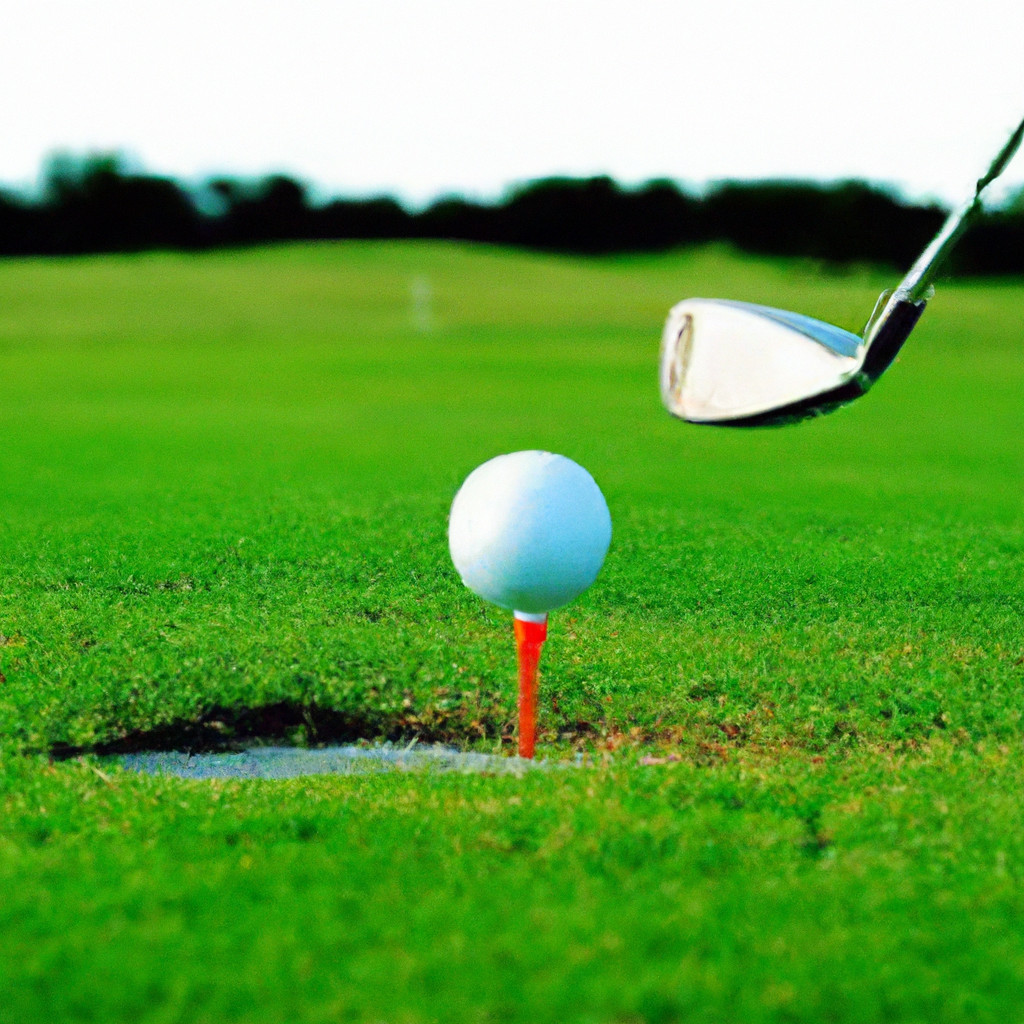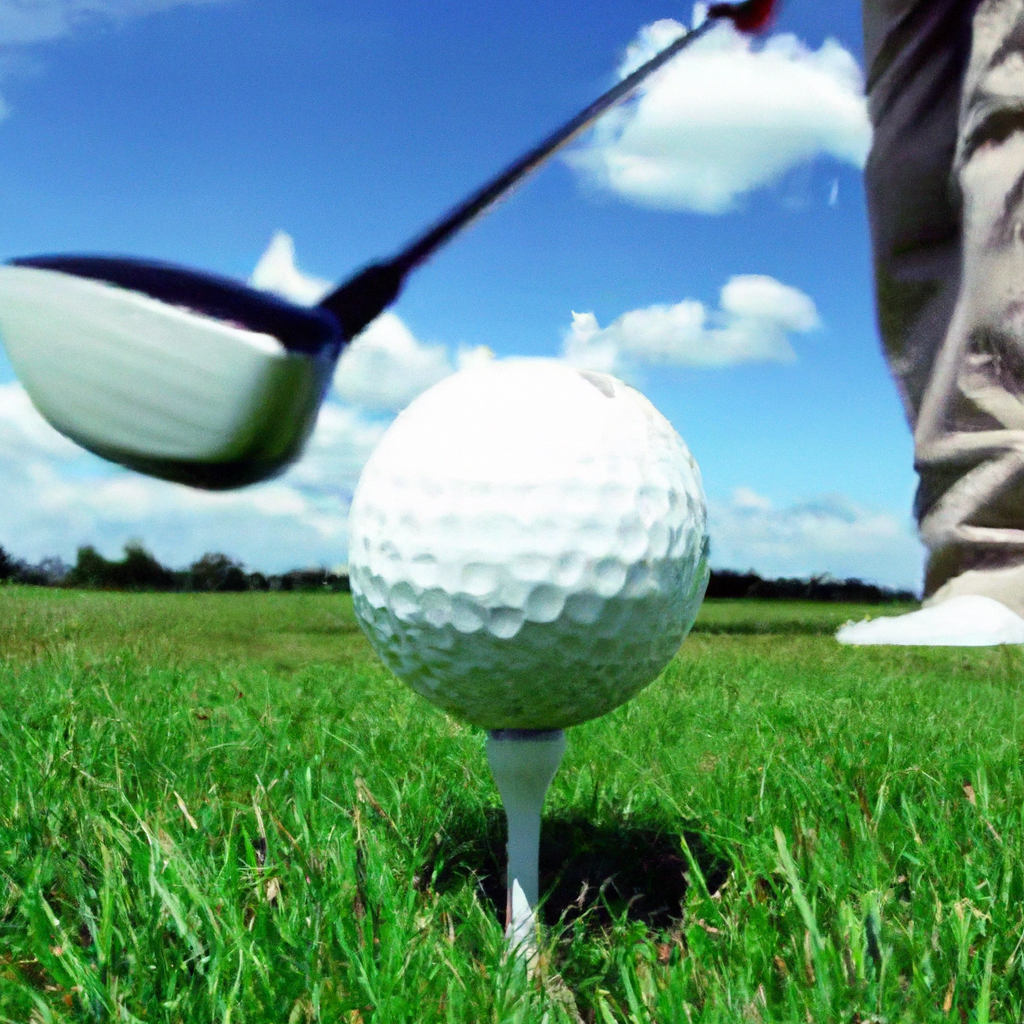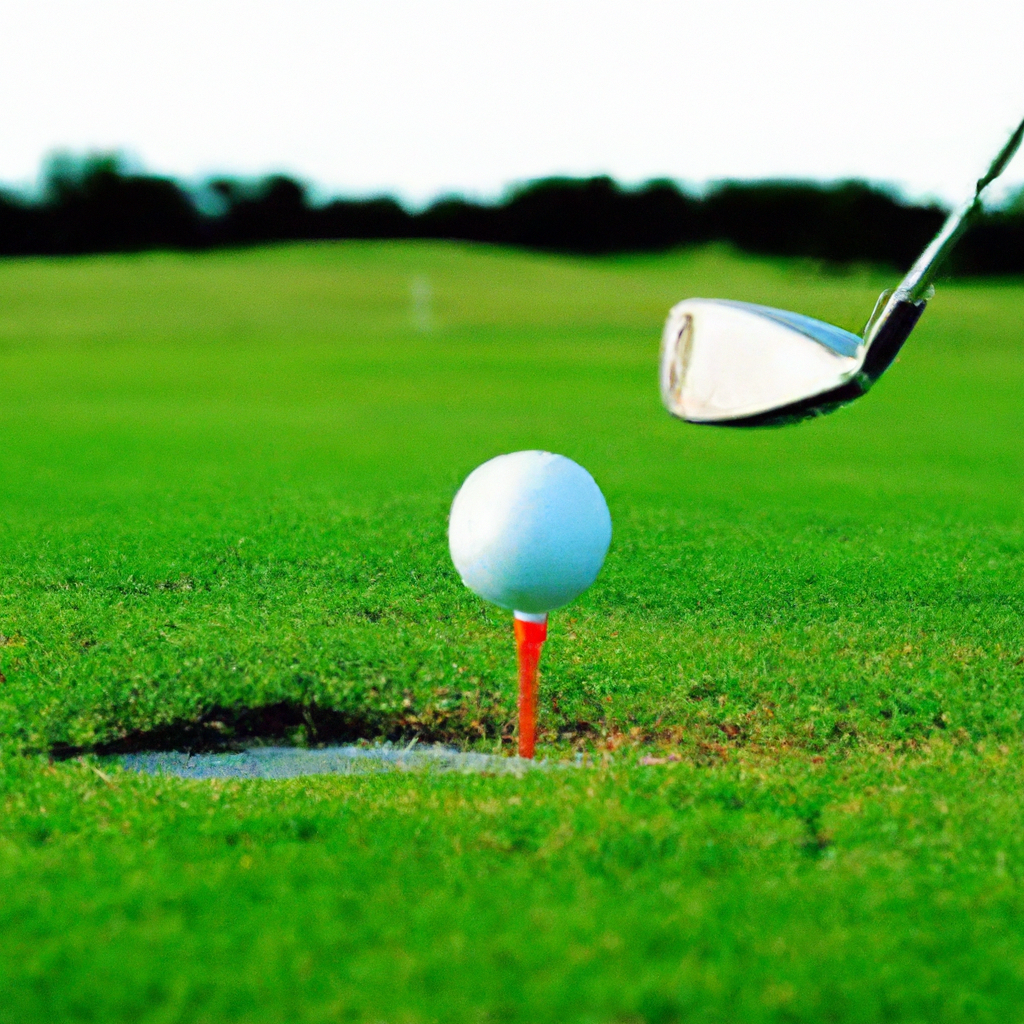We may earn money or products from the companies that may be mentioned in this post.
Imagine yourself on the golf course, perfectly swinging your club and watching in amazement as the ball soars through the air, only to land gracefully on the green and spin back towards the hole. Creating backspin on a golf ball is not just a skill reserved for the pros – it’s an art that you too can master. In this article, we will explore the techniques and tips that will unlock the secret to achieving that satisfying backspin on your golf shots. Get ready to impress your fellow golfers and take your game to new heights. Get ready to master the art of creating backspin on a golf ball. Let’s dive in!

Understanding Backspin on a Golf Ball
Definition of Backspin
Backspin refers to the rotation of a golf ball in the opposite direction of its flight. When a golf ball is struck with backspin, it generates lift, allowing it to stay in the air for a longer time and have a steeper descent upon landing. This rotation is crucial in creating control and precision in golf shots.
Importance of Backspin in Golf Shots
Backspin plays a vital role in several aspects of the game. Firstly, it enables golfers to stop the ball on the green more effectively, reducing the likelihood of it rolling too far away from the desired target. Secondly, backspin allows players to control the distance the ball travels in the air, which is particularly useful when navigating hazards or playing in adverse weather conditions. Lastly, backspin helps golfers shape their shots and execute various techniques, giving them the ability to hit draws, fades, and specialty shots.
Equipment and Ball Selection
Choosing the Right Golf Ball
Selecting the appropriate golf ball is crucial for generating backspin. Look for balls that offer a softer feel and higher spin rate. These characteristics promote increased friction between the clubface and the ball, resulting in more backspin. Manufacturers often indicate the spin rate on the packaging, providing valuable information for your selection.
Using the Correct Clubs
Different clubs have varying degrees of loft, which affects the ability to generate backspin. The wedges, such as the pitching wedge, sand wedge, and lob wedge, are particularly effective in producing backspin due to their higher loft angles. These clubs create a steeper trajectory, allowing for more spin on the ball. It’s important to have a well-rounded set of clubs to ensure you have the right options for generating backspin in different situations.
Clean and Groove Your Wedges
Regularly cleaning and grooving your wedges is essential for maximizing backspin. Dirt, grass, and debris can accumulate on the clubface and groove, reducing friction and spin. By using a golf brush or towel to clean the face and groove after each shot, you maintain optimal surface contact and increase the likelihood of creating backspin.
Mastering the Technique
Grip and Stance
The grip and stance are fundamental aspects of generating backspin. A proper grip ensures the clubface remains square at impact, allowing for clean contact and maximum spin. Additionally, the stance should promote a downward strike on the ball, enabling you to compress it and generate backspin. Experiment with different grips and stances to find the combination that works best for you.
Ball Positioning
The position of the ball in your stance affects the club’s angle of attack and, therefore, the amount of backspin created. For irons and wedges, slightly forward of center is recommended to ensure a downward strike and prevent excessive backspin. However, for specialty shots like flop shots or high soft shots, moving the ball more towards the front of your stance can assist in generating additional backspin.
Swing Path and Club Face Angle
The path of your swing and the angle of the clubface at impact significantly influence the amount of backspin produced. A shallow swing path with an open clubface will result in lower backspin, while a steeper, more downward swing path with a square or closed clubface will enhance backspin. Focus on maintaining a consistent swing path and ensuring the clubface remains stable at impact to generate optimal spin.
Controlled Swing Speed
Controlling your swing speed is crucial for generating backspin. A fast swing speed often leads to a lower spin rate, as the ball is compressed against the clubface for a shorter duration. Conversely, slowing down your swing speed allows for increased compression and increased spin. Practice swing tempo and ensure a smooth acceleration through impact to maximize backspin.

Creating Spin with Wedges
Understanding Loft and Bounce
Loft and bounce are critical elements in generating backspin with wedges. The loft refers to the angle of the clubface, while the bounce refers to the angle between the leading edge and the sole of the club. Higher loft angles provide a greater opportunity to generate backspin, while bounce helps the club glide through the turf smoothly.
The Role of Grooves
The grooves on your wedge play a crucial role in creating backspin. These grooves channel away moisture and debris, maximizing friction between the clubface and ball. Ensure your wedges have well-maintained and sharp grooves, as dull or worn-out grooves will significantly reduce spin potential. Regularly clean and inspect your wedges to maintain optimal groove performance.
Correct Angles for Impact
The angle of attack and the clubface angle at impact are crucial when generating backspin with wedges. To achieve optimal results, focus on a steep angle of attack, striking the ball before the turf. Additionally, positioning the clubface slightly open at address and ensuring it remains square at impact will promote greater spin.
Practicing Pitching and Chipping
Pitching and chipping are ideal scenarios to practice generating backspin with your wedges. By experimenting with different grips, ball positions, and swing paths, you can develop a feel for the amount of spin you can produce. Target landing spots with varying distances to refine your control and consistency. Regular and deliberate practice in these areas will significantly improve your ability to generate backspin on command.
Utilizing the Right Technique for Iron Shots
Understanding Clubhead Speed
The speed at which you swing the clubhead significantly affects the amount of backspin generated with iron shots. A faster swing speed tends to generate less backspin, while a slower swing allows for enhanced compression and more spin. Experiment with various swing tempos to find the optimal balance between distance and spin.
Implementing Proper Delivery
Delivering the club properly through impact is crucial in achieving the desired backspin with iron shots. Focus on maintaining a downward strike on the ball, compressing it against the clubface. Ensure your hands are slightly ahead of the ball at impact to promote a crisp, descending blow that maximizes spin. Proper sequencing and timing of the swing are essential to create the backspin you desire.
Importance of Downswing Path
The path of the downswing plays a significant role in generating backspin with iron shots. A steeper downswing path produces a steeper angle of attack, enabling greater compression and spin. Practice shallowing the club on the backswing and delivering it on a slightly steeper path during the downswing to optimize backspin potential.
Mastering the Lag
The lag, or the angle formed between the clubshaft and your lead forearm during the downswing, is crucial in generating backspin. By maintaining a lag and avoiding early release or casting of the club, you preserve the energy stored in the club and transfer it to the ball at impact. This transfer of energy contributes to increased spin. Focus on proper hand and wrist positions to maximize lag and improve backspin.
Special Techniques for Backspin
Draw and Fade Shots
Creating backspin with draw and fade shots adds an additional level of control and artistry to your golf game. By adjusting your grip and setup, you can manipulate the ball’s flight and create more sidespin, resulting in pronounced hooks or slices. Learning to control these shots while still generating backspin requires practice and experimentation. Consult with a golf professional to learn the proper techniques and mechanics for executing draw and fade shots with backspin.
Backspin from the Rough
Generating backspin from longer grass, such as the rough, presents unique challenges. The increased friction between the grass and the clubface can reduce spin potential. To optimize backspin from the rough, focus on maintaining a steeper angle of attack, striking the ball cleanly, and ensuring a square clubface at impact. Experiment with different swing speeds and adjustments to your setup to maximize backspin from the rough.
Creating Spin on Bunker Shots
Bunker shots require a different technique to create backspin due to the sand’s loose and unpredictable nature. By opening the clubface and taking slightly more sand at impact, you encourage the ball to release with backspin once it lands on the green. Practice bunker shots with various degrees of clubface openness and experiment with how much sand you take to develop a feel for generating backspin from bunkers.
Using Specialty Shots
Various specialty shots, such as flop shots, high soft shots, and low spinning shots, demand specialized techniques to generate backspin. Flop shots require an open clubface, a steep angle of attack, and precise timing to execute a high trajectory with great spin. High soft shots involve hitting the ball with a higher launch angle and softer landing. Low spinning shots often require a lower trajectory and increased roll-out upon landing. Practice these shots with the guidance of a golf professional to develop the necessary techniques for adding backspin to your repertoire.
Course Conditions and Strategies
Analyzing the Greens
Understanding the characteristics of the greens is essential for effectively utilizing backspin. Consider factors such as green speed, firmness, and slope, as they impact how the ball will react upon landing. Faster greens will generally promote more backspin, while softer greens may require adjustments in how you approach your shots. Spend time observing the greens during practice rounds and adjust your strategies accordingly to take advantage of backspin.
Considering Weather Factors
Weather conditions, such as wind and rain, significantly affect the ability to generate backspin. Wind can influence the ball’s flight, altering the trajectory and spin. Rain can make the greens softer, promoting more backspin. Consider these factors when selecting clubs, shot strategies, and adjustments to your technique to optimize backspin in various weather conditions.
Shot Selection on Different Lies
Different lies on the course present varying challenges when it comes to creating backspin. From tight lies on the fairway to different types of rough, each lie requires adjustments in technique and shot selection. For tight lies, focus on creating a shallow angle of attack and clean contact to maximize backspin. In thicker rough, adjust your setup and swing path to account for the additional resistance. Practicing from different lies will help develop your ability to generate backspin in various course conditions.
Strategies for Different Hole Designs
Backspin can have a significant impact on your strategies when approaching different hole designs. Shorter par 3s, for example, may require precise backspinning shots to hold the green. Par 5s, on the other hand, may offer opportunities to generate backspin on approach shots to set up birdie or eagle opportunities. Analyze each hole’s design, including fairway undulations, green contours, and hazards, to develop effective strategies for utilizing backspin and improving your scoring opportunities.
Developing Consistency
Maintaining a Repeatable Swing
To generate backspin consistently, it is crucial to develop a repeatable swing. A consistent swing allows you to fine-tune your technique and make adjustments when needed. Focus on maintaining the fundamentals of grip, stance, and swing mechanics to establish a reliable swing that consistently creates backspin on demand.
Consistent Wedge and Iron Strikes
Consistency in striking the ball is vital for generating backspin with wedges and irons. Quality contact establishes the necessary friction between the clubface and the ball to create spin. Regularly practicing your wedge and iron strikes, paying attention to ball-turf interaction and developing a consistent divot pattern, will greatly improve your ability to generate backspin consistently.
Analyzing and Adjusting for Mistakes
Even the best golfers make mistakes, and it’s important to analyze and adjust when things don’t go as planned. If you notice a lack of backspin or excessive spin, assess your swing mechanics, ball position, and club selection. Identify any potential errors and make the necessary corrections to improve your results. Regular self-assessment and seeking guidance from a golf professional will help you troubleshoot and correct mistakes to consistently generate backspin.
Practicing for Backspin
Range Drills for Spin Control
Practicing on the driving range provides an excellent opportunity to focus on generating backspin. Set aside dedicated practice sessions to experiment with different swings, grips, and club selections. Focus on hitting shots with varying trajectories, distances, and amounts of spin. Pay close attention to the results and adjust your technique accordingly. Range drills specifically designed for backspin control, such as target-focused sessions or hitting shots with reduced swing speed, can accelerate your progress in mastering backspin.
Targeted Short Game Practice
The short game is where backspin plays a critical role, and targeted practice is essential. Allocate practice time specifically for pitching, chipping, and bunker shots to develop a feel for generating backspin in these situations. Utilize various targets on the practice green, focusing on landing spots, to refine your control and precision. Regularly dedicating time to short game practice will greatly enhance your ability to create the desired backspin when it matters most.
Simulating Realistic Situations
Practicing in realistic situations helps replicate the challenges you may encounter on the course. Set up practice scenarios that mimic specific on-course shots, such as approach shots from tight lies, pitch shots over hazards, or bunker shots with backspin requirements. By simulating these situations, you develop the necessary muscle memory and mental fortitude to execute backspin shots with confidence during actual rounds.
Troubleshooting and Common Mistakes
Hitting the Ball Too Hard
One common mistake when trying to generate backspin is hitting the ball too hard. Over-exerting yourself and swinging with excessive force can hinder your ability to create the proper contact and control needed for backspin. Focus on maintaining a smooth and controlled swing tempo that allows for maximum clubface-to-ball contact, leading to optimal backspin.
Inconsistent Groove Maintenance
Neglecting to regularly clean and maintain the grooves on your clubs can significantly impact backspin production. Dull or clogged grooves reduce friction and limit your ability to generate spin. Make it a habit to clean your clubs after each round or practice session, ensuring the grooves are free from dirt and debris. Additionally, inspect your clubs periodically and consider having them professionally regrooved when necessary to maintain peak backspin performance.
Incorrect Club Selection
Choosing the wrong club can hinder your ability to generate backspin. Each club has different degrees of loft and, consequently, varying spin potential. Using a club with insufficient loft for the desired shot can limit your ability to generate backspin. Consider the trajectory and distance you wish to achieve, and select the appropriate club that allows for ample backspin generation in those situations.
Neglecting Proper Technique
The correct technique is crucial for consistently generating backspin. Neglecting proper grip, stance, and swing mechanics can greatly impact your ability to create the desired spin. Continually focus on refining your technique, seeking guidance from a golf professional if necessary. Regularly incorporate technique-focused practice sessions to reinforce proper habits and improve your backspin consistency.
By understanding the mechanics and techniques involved, selecting the right equipment, and practicing purposefully, you can master the art of creating backspin on a golf ball. Incorporate these strategies into your game, stay patient, and enjoy the process of enhancing your control, precision, and shot-making abilities. With dedication and practice, you’ll be able to add a new level of skill and artistry to your golf game through the mastery of backspin.
